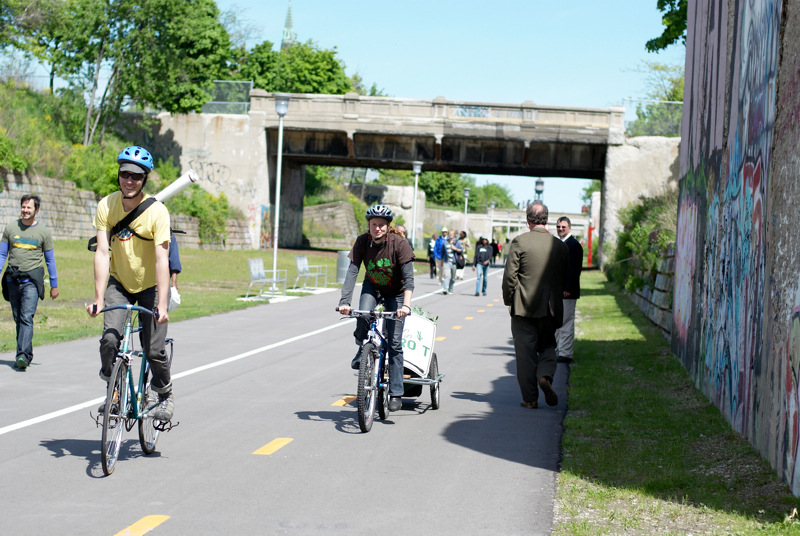In my work at the Corktown Economic Development Corporation/Human Scale Studio this summer, we often think about how to make cities friendlier to pedestrians. While scanning the news I was happy to see that a recent report from Smart Growth America, in conjunction with The George Washington University’s Center for Real Estate & Urban Analysis, includes Detroit in its “top tier” of Development Momentum rankings. This indicates that the city’s walkability is trending up rapidly. Projects such as the riverfront restoration and Dequindre Cut Greenway helped secure this ranking.
This news reflects progress in the city as its residents start to enjoy the numerous health and economic benefits of walkable neighborhoods. These benefits are well documented in scientific research, and we have learned about some of the top reasons why walkability is important in an urban environment. These include the following:
At our partner organization, Human Scale Studio, we have made significant efforts to increase walkability in the Corktown neighborhood. We recently won the Knight Cities Challenge award for our People First project, and we will distribute 12 grants of $5000 to selected fellows to fund transformative projects aimed at making Michigan Avenue a more complete street. The benefits of walkability are wide-reaching, and the findings of Smart Growth America and GWU indicate that the city of Detroit and its activists are serious about improving walkability and seizing these benefits.
Still, in designing more walkable communities, we must remember that improving walkability alone is not enough to secure a sustainable and prosperous future for a neighborhood or region. Studies have shown that HUD-assisted housing is more likely to be in walkable neighborhoods but also more likely to be in neighborhoods of “lower quality,” with higher incidence of segregation and low-quality schooling. In other words, walkability alone doesn’t “create” a neighborhood, as other shortcomings can offset the advantages of walkability. For example, this article leads with the story of a woman who was happy to see her son walk across the street to school only to later realize that this convenience was useless because of the school’s poor quality.
The presence of desirable facilities alone gets residents out of their houses, but walkability matters less when there aren’t desirable locations to walk to. In the development of Detroit and other cities across the country, a foundation of strong education, transportation, public services, and general financial solvency are must-haves. In the wake of this exciting news it is important to remember that walkability is just the start.
This news reflects progress in the city as its residents start to enjoy the numerous health and economic benefits of walkable neighborhoods. These benefits are well documented in scientific research, and we have learned about some of the top reasons why walkability is important in an urban environment. These include the following:
- Ample footpaths with access to recreation and retail areas encourage walking and exercise outdoors. This is especially important in a country where close to 35% of adults are obese and 93% of the average citizen’s time is spent in closed buildings or vehicles.
- Walking takes cars off the road, which decreases traffic and reduces emissions.
- Strong walkability increases property values and decreases rates of foreclosure.
- Walkable neighborhoods see decreased rates of crime, including violent crime and murder.
- The quality of spaces surrounding people drastically impact their quality of life; one study suggests that having a more complex and walkable environment requires maintaining a more complex cognitive map and can help ward off Alzheimer’s Disease.
At our partner organization, Human Scale Studio, we have made significant efforts to increase walkability in the Corktown neighborhood. We recently won the Knight Cities Challenge award for our People First project, and we will distribute 12 grants of $5000 to selected fellows to fund transformative projects aimed at making Michigan Avenue a more complete street. The benefits of walkability are wide-reaching, and the findings of Smart Growth America and GWU indicate that the city of Detroit and its activists are serious about improving walkability and seizing these benefits.
Still, in designing more walkable communities, we must remember that improving walkability alone is not enough to secure a sustainable and prosperous future for a neighborhood or region. Studies have shown that HUD-assisted housing is more likely to be in walkable neighborhoods but also more likely to be in neighborhoods of “lower quality,” with higher incidence of segregation and low-quality schooling. In other words, walkability alone doesn’t “create” a neighborhood, as other shortcomings can offset the advantages of walkability. For example, this article leads with the story of a woman who was happy to see her son walk across the street to school only to later realize that this convenience was useless because of the school’s poor quality.
The presence of desirable facilities alone gets residents out of their houses, but walkability matters less when there aren’t desirable locations to walk to. In the development of Detroit and other cities across the country, a foundation of strong education, transportation, public services, and general financial solvency are must-haves. In the wake of this exciting news it is important to remember that walkability is just the start.

 RSS Feed
RSS Feed
